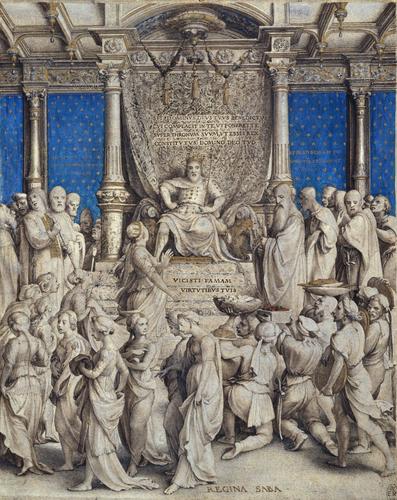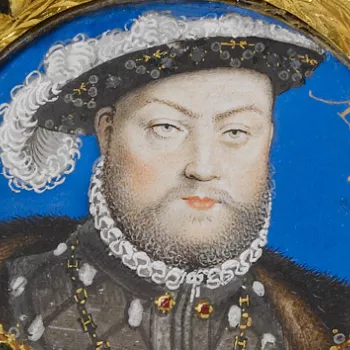Solomon and the Queen of Sheba c. 1535
Watercolour, bodycolour and gold paint on vellum laid onto card | 22.9 x 18.3 cm (vellum sheet) | RCIN 912188
-
A miniature painting of the figure of Solomon, which is suggestive of portraits of Henry VIII, sitting on a raised throne with Italianate figures in foreground. Inscriptions adapted from II Chronicles and I Kings describe the Queen of Sheba's visit to meet King Solomon.
The subject of this miniature is of the greatest significance for England's history. It refers to the establishment of the Church of England with Henry VIII as Supreme Governor in whom both temporal and spiritual power were vested. This development coincided with the spread of the Reformation elsewhere in Europe but was closely connected to the difficulties that the King had encountered in obtaining a divorce from his first wife, Catherine of Aragon. After all links with the authority of the Pope in Rome were severed, the King's divorce was finalised in May 1533 and the Church of England was formally established by the Act of Supremacy in the following year.
Holbein's composition uses biblical narrative (I Kings 10: 1-13 and II Chronicles 9: 1-12) to illustrate the redefinition of Henry VIII's power. The central figure of the King is shown as Solomon enthroned wearing a crown and holding a sceptre. On the steps of the throne, seen in profile, is the Queen of Sheba (the personification of the Church) in the act of addressing the King. Her salutation is inscribed in Latin on either side of the throne and on the curtain. It ordains that the power which is given to Solomon - and so by extension to Henry VIII himself - comes from God alone. The inscription on the steps is also composed of words spoken by the Queen of Sheba. The figures in the foreground represent the retinue of the Queen of Sheba, while those on either side of the throne are members of Solomon's court.
Although always described as a miniature, Solomon and the Queen of Sheba has a strong narrative element which should be seen in the context of manuscript illumination. The high degree of finish, together with the plentiful use of silver (now sulphided to black) and gold, suggests that it may have been intended for presentation, probably to the King himself. This image of Henry VIII may be the first portrait by Holbein of the King whose court he so vividly portrayed during his second visit to London, beginning in 1532. It is the only original likeness of Henry VIII by Holbein to have survived in the Royal Collection. The Renaissance style of the architecture is similar to that used by Holbein in the Whitehall Mural of 1537 (destroyed 1698 but known through a copy).
Inscribed in the foreground REGINA SABA (Queen of Sheba); and on either side of the throne BEATI VIRI TVI ... ET BEATI SERVI HI TVI / QVI ASSISTVNT CORAM TE ... OMNITPE ET AVDIVNT / SAPIENTIAM ... TVAM (Happy are thy men, and happy are these thy servants, who stand continually before thee, and hear thy wisdom: II Chronicles 9: 7); on the curtain behind Solomon SIT DOMINVS DEVS TVVS BENEDICTVS, / CVI COMPLACIT IN TE, VT PONERET TE / SVPER THRONVM SVVM, VT ESSES REX / CONSTITVTVS DOMINO DEO TVO (Blessed be the Lord thy God, who delighted in thee, to set thee upon his throne to be King elected by the Lord thy God: adapted from II Chronicles 9: 8); on the steps VICISTI FAMAM / VIRTVTIBVS TVIS (By your virtues you have exceeded your reputation: II Chronicles 9: 6)
Catalogue entry adapted from Royal Treasures, A Golden Jubilee Celebration, London 2002Provenance
Henry VIII; Thomas Howard, Earl of Arundel, by 1642; Royal Collection by 1688
-
Medium and techniques
Watercolour, bodycolour and gold paint on vellum laid onto card
Measurements
22.9 x 18.3 cm (vellum sheet)
Category
Object type(s)
Other number(s)
RL 12188












